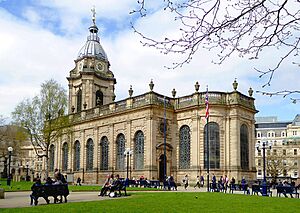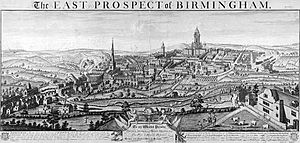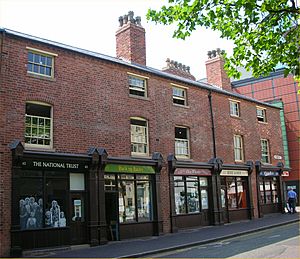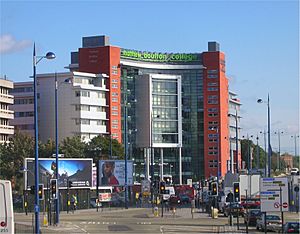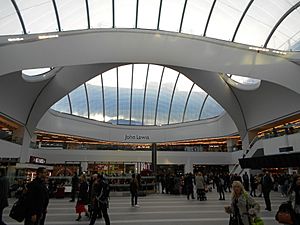Birmingham city centre facts for kids
Birmingham city centre, also known as Central Birmingham, is the main business area of Birmingham, England. It used to be part of Warwickshire county. After a big road called the Birmingham Inner Ring Road was removed, the city centre is now considered the area inside the Middle Ring Road. The city centre is getting a huge makeover with something called the Big City Plan. This plan is making the city centre about five times bigger and creating nine new areas.
Contents
Exploring Birmingham's City Centre
The city centre is divided into different areas, each with its own special feel. These areas are:
- City centre core
- Westside
- Eastside
- Southside
- Jewellery Quarter
- Gun Quarter
- Highgate
- Ladywood
- Digbeth
A Look Back: How the City Centre Changed
For a long time, a road called the Birmingham Inner Ring Road acted like a "concrete collar" around the city centre. It made it hard for people to walk around and stopped the city centre from growing. But after this road was removed, a massive project called the Big City Plan began. This plan is helping to rebuild and improve the city centre.
The Heart of the City: City Centre Core
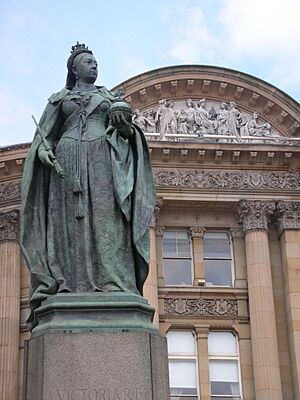
The city centre core is the oldest part of Birmingham. Here, you can see a mix of old buildings and new ones right next to each other. This area is roughly surrounded by where the old Birmingham Inner Ring Road used to be.
Important places in the core include Chamberlain Square, Old Square, and Victoria Square. You'll also find famous buildings like Birmingham Town Hall, Birmingham Museum and Art Gallery, St Philip's Cathedral, and the Victoria Law Courts.
Fun Places to Visit in the City Centre
Birmingham city centre has many exciting places for visitors and cool landmarks.
Cool Spots and Shopping
- Brindleyplace: This area used to be old, empty warehouses next to canals. Now, it's a lively spot with public squares, offices, shops, and the Sea Life Centre. The old Oozells Street Board School was even turned into the Ikon Gallery.
- Gas Street Basin: Close by is this historic canal basin, a great place to see boats.
- International Convention Centre: This is a huge building where big events and conferences happen.
- Symphony Hall: Right next to the Convention Centre, this is known as one of the best places in the world to hear music. It looks out over Centenary Square.
- Centenary Square: This square was updated in 1989. It has the Hall of Memory and Baskerville House.
You can also find other public squares like Victoria Square, Chamberlain Square, and Old Square. There are also squares inside the Bullring Shopping Centre and at the Custard Factory.
For shopping, the main places are the Bullring Shopping Centre, Corporation Street, New Street, and High Street. Other shopping spots include The Mailbox and Grand Central Shopping Centre (above New Street station). Great Western Arcade is one of several cool shopping arcades. If you like unique shops, check out Digbeth.
Nightlife and Culture
Broad Street is the main area for Birmingham's nightlife, with many clubs and bars. You'll find more clubs in Digbeth too.
For culture, visit the Birmingham Central Library in Chamberlain Square. The Birmingham Museum & Art Gallery and the Council House are in the same building, with the famous clock tower, Big Brum. Thinktank, a science museum, opened in 2002 in the Millennium Point complex in Eastside.
The Museum of the Jewellery Quarter tells the story of this historic area. Also in the Jewellery Quarter are the Royal Birmingham Society of Artists and St. Paul's Gallery. You can also see the Birmingham Back to Backs on Hurst Street. These are the last surviving old "back-to-back" houses in the city, restored by the National Trust.
The Colmore Row area is special because of its historic buildings, including St. Philip's Cathedral. The Jewellery Quarter is also a protected historic area. Other cultural areas in the city centre include the Chinese Quarter, Irish Quarter, and the Learning and Technology Quarter.
Learning in the City Centre
Several universities and colleges have campuses in the city centre. Aston University is based here, and Birmingham City University also has facilities. In the Eastside area, you'll find the Matthew Boulton College campus and the New Technology Institute, both part of Birmingham Metropolitan College. Birmingham Ormiston Academy is also nearby. This area is sometimes called the Aston Triangle.
Around this area, there are many tall buildings that offer student housing and classrooms.
Getting Around Birmingham City Centre
Trains and Trams
New Street station is the main train station in the city centre. It connects Birmingham to local and national train lines. The station was first built in 1854 and rebuilt in 1967. A huge renovation project called Gateway Plus finished in 2016. This project cost £600 million and added a new John Lewis department store and many other shops.
Other train stations in the city centre include Moor Street, Snow Hill, Bordesley, and Jewellery station. Ten different train routes serve the city centre. The very first train station in the city centre was Curzon Street railway station, built in 1838.
The West Midlands Metro tram system opened in 1999. It stops at Grand Central, Bull Street, St Chads, St Paul's, and Jewellery Quarter. The tram line is currently being extended to Centenary Square and will go to Five Ways in the future.
Buses and Coaches
Birmingham city centre is the main hub for the city's bus system. Most buses stop at Bull Street, Corporation Street, and Moor Street, Queensway. Most of these buses are run by National Express West Midlands.
The city centre is also where national coach services start and end. Birmingham Coach Station is owned by National Express, who are moving their main offices to the city. A temporary coach station is currently being used while the main one is being prepared for redevelopment.
Driving and Walking
Cars are not strongly encouraged in the city centre. Many areas have been made for pedestrians only so people can walk safely without cars. Some large roundabouts have been changed to traffic light junctions to make it easier for pedestrians to cross.
There are still parts of the old Birmingham Inner Ring Road (Queensway) that act as a "half-ring" for cars, with underpasses for through traffic. This helps reduce traffic in other parts of the city centre.
You'll find many multi-storey car parks in the city centre, mostly owned by private companies.


